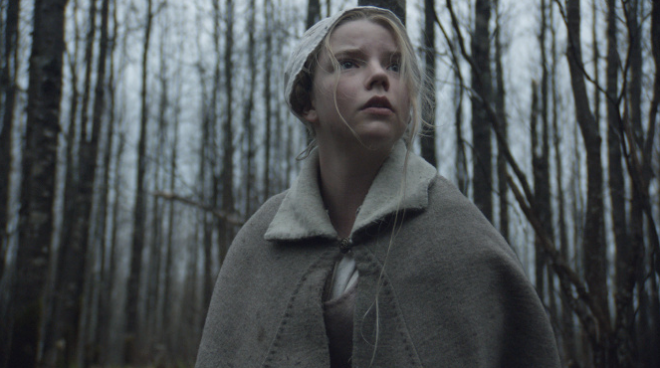
The Witch: A New England Folk Tale was the most talked about film at Sundance last year. An unshakeable period horror-film, about evil forces terrorizing a pilgrim family, it definitely lives up to its reputation. Even more, writer/director Robert Eggers has succeeded in making an unnerving mood-piece about familial discord, as well as a horrifying story of unholy menace. With the artful sophistication of a European film, the movie, by turns disquieting and thunderously dramatic, wallops you almost immediately with the unspeakable, before then wearing you down with drawn-out portent. Like a firelight nightmare of nascent America, it turns history into a tragedy of physical and spiritual isolation, into a creation myth wherein the monster is scarier because it comes from inside and out.
The film tells of William (Ralph Ineson) and Katherine (Kate Dickie) and their four children: Thomasin (Anya Taylor-Joy), Caleb (Harvey Scrimshaw), twins Mercy and Jonas (Ellie Grainger and Lucas Dawson), and baby Samuel. In early moments, the family willingly leaves the safety of a New England settlement, due to conflicts of faith, and finds a new home in a log cabin near a brook on the edge of the forest. Since the film is based on folklore, fairy tales and various historical records and diaries, it places us into the period with effective authenticity. The dialogue makes use of obsolete words like “thee”, “thy”, “hither” and “thither”, and the actors bring it off well. All — save for Taylor-Joy, who has a modern prettiness — appear to have arrived via time-machine, too. Even the creepy hymns and nursery rhymes the children chant seem to have come from the lips of passengers on the Mayflower.
The family starts preparing for the harsh winter, but bigger problems occur when baby Samuel vanishes from under Thomasin’s nose, literally. After a week of searching, they resolve that the poor babe must have been taken by a wolf. However, there are strong hints that something far more terrifying than wolves lurks within the woods. The mysteriousness of that danger propels the film forward, and it is compounded by the everyday dangers of surviving in the wilderness. The director utilizes nearly every environmental feature to express the difficulty of existing in nature. From the eerie morning mist, and the forest’s twisted thicket of limbs, to the night so dark that it swallows up hope with the light — there’s fatalistic doom everywhere. Even typically nice animals are threatening; an elusive rabbit comes and goes like the Devil’s recon scout, while the family goat, tar-black with big curly horns, whispers to the twins, or so they say.
Director Eggers, making his debut, prefers ominous severity in the tradition of Kubrick and Carpenter. He uses mostly static shots and slow, sinister tracking moves. Over certain cuts, he’ll employ cacophonous sound-effects — an axe chopping wood, say — that repurpose transitions into unsettling jolts. The melodious score, perhaps a bit forceful at times, is nevertheless a perfect underline for the foreboding circumstances; it evokes the demonic chaos of an orchestral hellfire chorus. Further, Eggers understands that what scares the audience most about a horror film is not knowing what’s waiting for them, just outside the frame. Often, he instructs the actors to stare meaningfully off-screen, as if they’re troubled by something they see, but he withholds the reveal long enough to terrorize us. We’re as helpless as the characters, tormented by what might be there, beyond our view.
While the unknowable threat grows, and farming and hunting prove more difficult than anticipated, tensions within the family are unleashed. William, who often roars from off-screen like an authoritarian narrator, is a prideful man holding dearly to his piety, as if religion alone will be enough to save him. Katherine is the embodiment of grief — for her children, for her lost youth and her home in England; she admits that her heart has grown cold. The oldest son, Caleb, who’s about twelve, is caught between childish lust and fear of damnation. The frolicsome twins claim they’ve seen and heard unnatural things, but are they still just pretending? These are perhaps the most religious people I’ve seen in a horror film, a genre that, through its history, has been thoroughly intertwined with religion and morality. The irony is, as pilgrims, they’ve traveled the world looking for God but found the Devil instead.
As the movie progresses, it gets relentlessly intense and builds toward tremendous horrors. It also settles more on the teenage daughter, Thomasin, as a subject, the hinge on whom its core ideas hang. Like it might in Carrie by way of The Crucible, her blossoming sexuality entangles inescapably with the violent powers at large, for she, a symbol of Eve’s original sin, is the greatest victim of puritanism. She represents its essential binary, that if you’re not a servant of Christ you must be one of Satan. There are four prominent patriarchies within the film: society, lord over at the beginning by a council of men; the church; the family; and, finally, the coven. Thomasin is their reluctant minion, and the central question emerges: is the titular witch really hiding in the woods, or somewhere closer to home? The Witch: A New England Folk Tale remains brilliantly abstract about its supernatural elements, but it leaves you thinking that, perhaps, the cold oppressive hypocrisy of puritanism is what really created the evil where it wasn’t before.